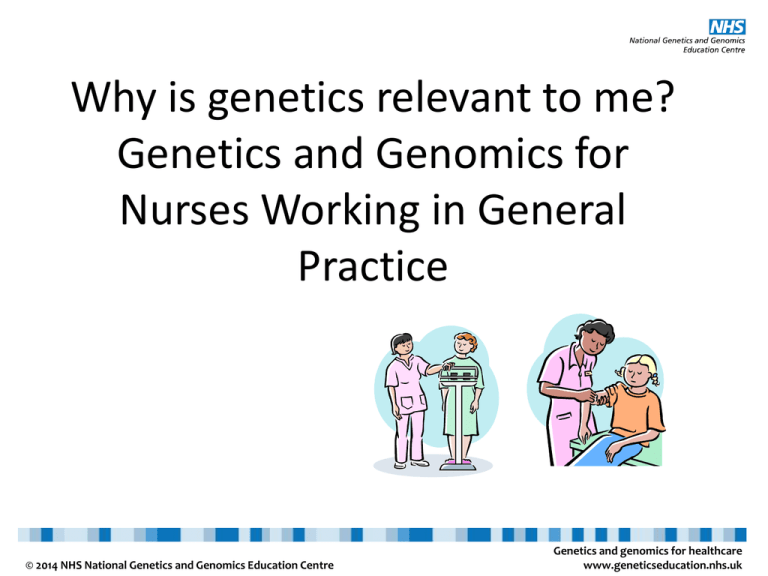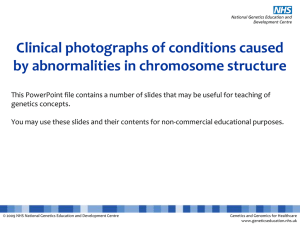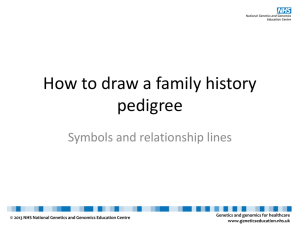
Why is genetics relevant to me?
Genetics and Genomics for
Nurses Working in General
Practice
© 2014 NHS National Genetics and Genomics Education Centre
Genetics and genomics for healthcare
www.geneticseducation.nhs.uk
Aims of this session
• To give General Practice Nurses an overview of how
Genetics and Genomics fits into their Practice
• To describe the underpinning core genetic concepts
• To demonstrate the inheritance patterns of some
common conditions seen in primary care
• To discuss referral pathways
© 2014 NHS National Genetics and Genomics Education Centre
Genetics and genomics for healthcare
www.geneticseducation.nhs.uk
Why do I need to think about Genetics? The Practice
Nurses Role
• Supporting patients who are anxious about the
inheritable nature of their condition
• Information giving -modes of inheritance, genetic
referral process
• Awareness and referral on to medical staff
• Genetics in common long term conditions
© 2014 NHS National Genetics and Genomics Education Centre
Genetics and genomics for healthcare
www.geneticseducation.nhs.uk
1 in 10 patients seen in primary
care has a disorder with a genetic
component
Hopkinson, I. Presentation at Reality not hype: the new genetics in primary care, 2004.
© 2012 NHS National Genetics Education and Development Centre
© 2014 NHS National Genetics and Genomics Education Centre
Genetics and genomics for healthcare
www.geneticseducation.nhs.uk
ALERT
ASK
ACT
Know the clues
that might indicate
a genetic condition
Collect appropriate
family history
information
Act on the
information you
have
© 2012 NHS National Genetics Education and Development Centre
© 2014 NHS National Genetics and Genomics Education Centre
Genetics and genomics for healthcare
www.geneticseducation.nhs.uk
ALERT
Know the clues
that might indicate
a genetic condition
© 2012 NHS National Genetics Education and Development Centre
© 2014 NHS National Genetics and Genomics Education Centre
Genetics and genomics for healthcare
www.geneticseducation.nhs.uk
General clues
• Multiple closely related people with the same
condition
• Disorders which occur at a younger age than usual
(e.g. colon cancer, breast cancer, dementia)
• Sudden cardiac deaths in people who seemed
healthy
• Three or more pregnancy losses
• Medical problems in children of parents related by
blood
• Congenital anomalies, dysmorphic features and
developmental delay
© 2012 NHS National Genetics Education and Development Centre
© 2014 NHS National Genetics and Genomics Education Centre
Genetics and genomics for healthcare
www.geneticseducation.nhs.uk
Making sense of the science……..
© 2014 NHS National Genetics and Genomics Education Centre
Genetics and genomics for healthcare
www.geneticseducation.nhs.uk
How it works –e.g.Cystic Fibrosis
Normal-CTFR gene codes for CFP embedded
in cell membrane. Involved in transport of
salt and H2O in glands that produce mucous.
e.g. Lungs, nose, pancreas or sweat
H2O & NaCl
Altered CTFR gene. CFP not functioning
leading to reduced transportation of salt
and water and sticky mucous
Sticky
accumulation
mucous
H2O & NaCl
H2O & NaCl
Sticky
mucous
H2O &
NaCl
H2O & NaCl
H2O & NaCl
H2O & NaCl
Sticky
mucous
H2O & NaCl
H2O & NaCl
H2O & NaCl
H2O & NaCl
H2O & NaCl
Cell membrane
Sticky
mucous
Sticky
mucous
H2O & NaCl
H2O & NaCl
© 2014 NHS National Genetics and Genomics Education Centre
Sticky
mucous
Sticky
mucous
Genetics and genomics for healthcare
www.geneticseducation.nhs.uk
© 2014 NHS National Genetics and Genomics Education Centre
Genetics and genomics for healthcare
www.geneticseducation.nhs.uk
Common Conditions seen in Primary Care
• Familial Hypercholesteroleamia – Autosomal
Dominant
• Cystic Fibrosis –Autosomal Recessive
• Breast Cancer –Sporadic or can be single gene
BRCA1/2 Autosomal Dominant
• Heart Disease-Multifactorial
• Diabetes-Multifactorial or MODY Autosomal
Dominant
© 2014 NHS National Genetics and Genomics Education Centre
Genetics and genomics for healthcare
www.geneticseducation.nhs.uk
Modes of Inheritance
Mitochondrial conditions
Chromosomal conditions
© 2014 NHS National Genetics and Genomics Education Centre
Genetics and genomics for healthcare
www.geneticseducation.nhs.uk
Autosomal Dominant
© 2014 NHS National Genetics and Genomics Education Centre
Genetics and genomics for healthcare
www.geneticseducation.nhs.uk
Autosomal Recessive
© 2014 NHS National Genetics and Genomics Education Centre
Genetics and genomics for healthcare
www.geneticseducation.nhs.uk
X linked Recessive
© 2014 NHS National Genetics and Genomics Education Centre
Genetics and genomics for healthcare
www.geneticseducation.nhs.uk
ASK
Collect appropriate
family history
information
© 2012 NHS National Genetics Education and Development Centre
© 2014 NHS National Genetics and Genomics Education Centre
Genetics and genomics for healthcare
www.geneticseducation.nhs.uk
Collecting appropriate information
• Establish biological relationships in the family
• Clarify the medical conditions that people in the
family have
© 2012 NHS National Genetics Education and Development Centre
© 2014 NHS National Genetics and Genomics Education Centre
Genetics and genomics for healthcare
www.geneticseducation.nhs.uk
General questions to gain a quick
overview of a genetic family history
Do you have any concerns about diseases or
conditions that seem to run on either your or your
partner’s side of the family?
Does anyone have a major medical, physical or
mental health problem?
Has anyone ever needed treatment in hospital?
© 2014 NHS National Genetics and Genomics Education Centre
Genetics and genomics for healthcare
www.geneticseducation.nhs.uk
What information should you collect?
•Information depends on the context and reason for
collecting it:
•Establish biological relationships
•Clarify the medical conditions that people have
•3 generations
•For each person:
•Full name
•Date of birth (or age)
•Date of death (or age died)
•Medical information (age at diagnosis)
© 2014 NHS National Genetics and Genomics Education Centre
© 2014 NHS National Genetics and Genomics Education Centre
Genetics and genomics for healthcare
www.geneticseducation.nhs.uk
Drawing a family tree
Marriage /
Partnership
(horizontal line)
Male
Female
/
Partnership that has
ended
Person whose sex
is unknown
P
Pregnancy
Offspring (vertical
line)
Miscarriage
X weeks
Affected Male &
Female
Parents and Siblings
Carrier Male & Female
© 2014 NHS National Genetics and Genomics Education Centre
© 2014 NHS National Genetics and Genomics Education Centre
Genetics and genomics for healthcare
www.geneticseducation.nhs.uk
© 2014 NHS National Genetics and Genomics Education Centre
© 2014 NHS National Genetics and Genomics Education Centre
Genetics and genomics for healthcare
www.geneticseducation.nhs.uk
ACT
Act on the
information
you have
© 2012 NHS National Genetics Education and Development Centre
© 2014 NHS National Genetics and Genomics Education Centre
Genetics and genomics for healthcare
www.geneticseducation.nhs.uk
Where to find information:
© 2014 NHS National Genetics and Genomics Education Centre
Genetics and genomics for healthcare
www.geneticseducation.nhs.uk
www.geneticseducation.nhs.uk
© 2012 NHS National Genetics Education and Development Centre
© 2014 NHS National Genetics and Genomics Education Centre
Genetics and genomics for healthcare
www.geneticseducation.nhs.uk
• Reassure
– Knowledge of the condition
– Local/national referral guidelines
• Refer
– To the GP or clinical genetics service
• Seek further advice
– Trusted sources of information
– Clinical Genetics Department On-Call Service
© 2012 NHS National Genetics Education and Development Centre
© 2014 NHS National Genetics and Genomics Education Centre
Geneticsand
andgenomics
genomicsfor
for healthcare
healthcare
Genetics
www.geneticseducation.nhs.uk
www.geneticseducation.nhs.uk
Making a referral
© 2014 NHS National Genetics and Genomics Education Centre
Genetics and genomics for healthcare
www.geneticseducation.nhs.uk
Consider the following scenarios how
would you respond?
• A mother is seeing you with her 10 year old son for
lifestyle advice as he has a high BMI. The mother has
read in the paper that there is a company that tests
DNA for obesity genes and brings the article to ask
for advice on whether to get her Son tested.
• A woman attending for cervical smear is worried
because her Aunt has been diagnosed with breast
cancer and her Grandmother also had breast cancer,
she wants to know if she could have a mammogram,
she is aged 42.
© 2014 NHS National Genetics and Genomics Education Centre
Genetics and genomics for healthcare
www.geneticseducation.nhs.uk
• One of the patients that you see regularly for
hypertension management is worried that they
might develop dementia as their father and maternal
grandmother have both developed it in their 80s.
• During an immunisation clinic a family asks you to
help explain a letter they have received from the
regional genetics centre. The baby has an autosomal
recessive condition and even though the letter
explains this the family are still uncertain about what
it means
© 2014 NHS National Genetics and Genomics Education Centre
Genetics and genomics for healthcare
www.geneticseducation.nhs.uk








